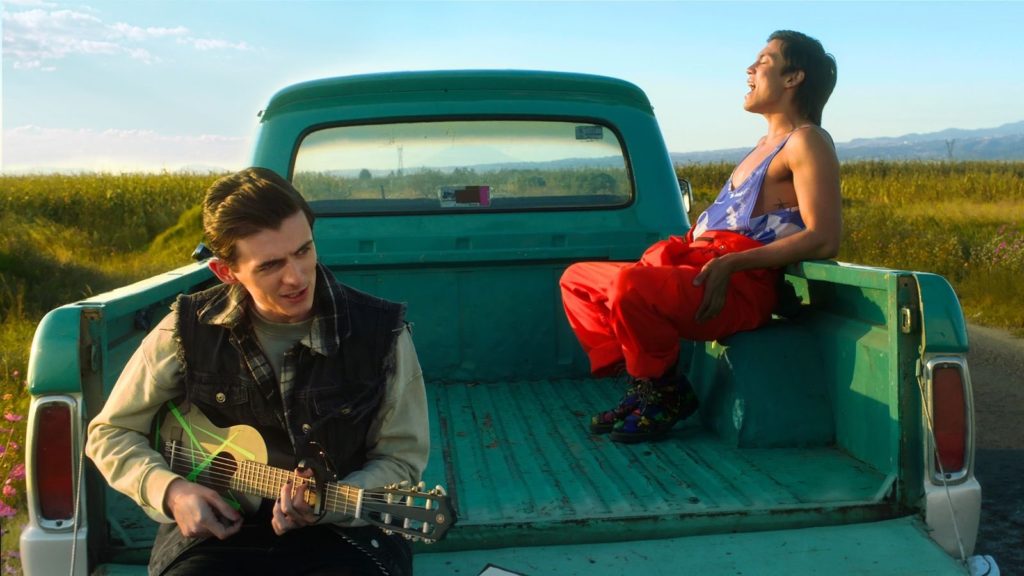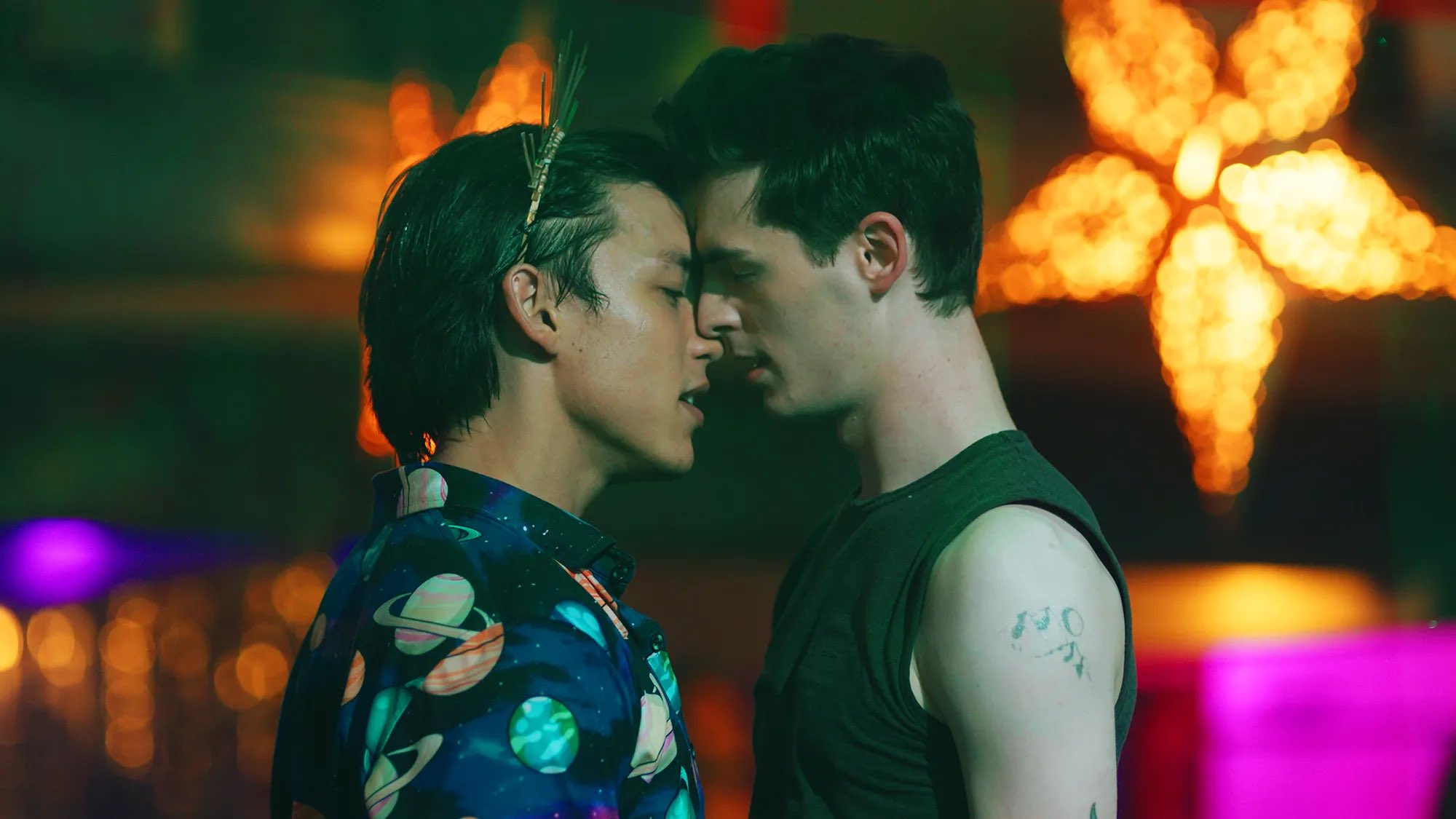The dazzling, sometimes uneven new movie musical LBGTQ love story Glitter & Doom made me a first-time fan of the 1990s indie folk group Indigo Girls…more than thirty years after many of their most famous songs became hits.
The colorful and kinetic film also made me a first-time fan of its many talented performers, both veterans and fresh faces, and of the behind-the-camera team that made it. It’s a heartfelt, flawed work that is nevertheless highly enjoyable – more revolutionary than its early-Almodovarian, candy-pop aesthetics and young love hijinks at first seem.
The spine of the film is a simple love story between irrepressible, glittery, aspiring circus performer Glitter, played by Tiger Beat-handsome Filipino-Scottish star Alex Diaz and sombre, aspiring singer-songwriter Gloom, played by pallid, whippet-thin and also dreamily handsome Brit stage/screen actor and singer Alan Cammish.
The two meet in a hectically-edited nightclub dance scene and fall instantly in love, their main obstacle being the 29 days before Glitter may have to leave for Paris for clown school. (You may have to will yourself to overlook moments of grating tweeness.) Their other main obstacles are their challengingmothers: Glitter’s is his tiger mom, played by a stylish-eye-patch-wearing, secretly vulnerable, unexpectedly wry mother Ming-Na Wen. Gloom’s love and alcohol-addicted ex-con mother is played by Missi Pyle. Both Wen and Pyle avail themselves nicely, capturing the complicated currents of mother-son relationships and both getting to show off their vocal chops.

The early scenes of the film are edited so quickly and are so busy that it’s difficult to understand what is happening. Thefilm’s story is told through twenty-five songs from 1980s/90s indie stars The Indigo Girls; the classic songs have been brilliantly reworked and updated by producer Michelle Chamuel. Once you understand how the songs and the scenes are working together, it becomes easier to settle in, though the enjoyment is the whole world of the film itself, less in the actual (or lack thereof) drama of the love story. As the story goes on, Glitter and Doom sweetly and lovingly help each other to take the steps needed to achieve each of their dreams.
The Indigo Girls themselves have been having a renaissancerecently, their most famous song Closer to Fine becoming even more iconic after appearing throughout last summer’s billion-dollar box office smash Barbie. Hopefully Glitter & Doom willintroduce a whole new generation to their soulful, catchy, profound song catalog. The Indigo Girls themselves, Amy Ray and Emily Saliers, make a number of supportive and good-spirited appearances throughout the film.
The quick cuts, cartoonish, bright colors and simple emotions echo the bl and manga love stories that are currently entrancing readers and viewers across the world. Unfortunately the constraints of a two hour film don’t allow for the type of richer character development newly seen in multi-hour TV series about young gay love – whether it be Heartstopper, 2Gether or Young Royals. But none of those pop culture productions have the unique benefit of a toe-tapping soundtrack to bring this young, hopeful love to singalong life.
Diaz and Cammish themselves are nice physical counterpointsand complement each other well, as do their voices – Cammish’syearning and bell-like clear, while Diaz’s is huskier and sweeter.Some of the songs are recast for the male leads, with Cammish’s“Little Revolution” being one of my favorites.
Near the end of the film – after Glitter has left for clown-school in Paris (the tweeness of this plot line is saved by a funny, sly cameo from Tig Notaro playing Glitter’s Parisian clown professor) – Doom finally gets his chance to sing his songs at the stylish supper club owned by loudly critical, quietly maternal Boston, played by LGBTQ icon Lea DeLaria. In the scene,thecamera cuts around the room to a sea of supportive faces, many of them older, often lesbian-identifying women including Delaria, Saliers and Ray. One of them is holding up a phone with Glitter watching his true love from Paris – thankfully without a clown nose. The collective support for these two young lovers in the room and throughout the movie can’t help but be incredibly poignant and moving.
One of Indigo Girls’ classic hits is titled Everything in Its Own Time (also reworked well for the film) and I think that aptly describes the appearance of this movie at this current moment. This movie likely couldn’t have been made in the early 1990s when the Indigo Girls were at their first peak of fame. In that era there were some ground-breaking cinematic gay love stories, whether it was My Beautiful Launderette, Maurice or Philadelphia, but those love stories always ended in doom and gloom. Even more relatively recent box office hits such as Brokeback Mountain or Call Me By Your Name have had sad, sometimes tragic endings. An LGBTQ cinematic love story that actually ends happily, with hope and collective support is its own little sort of revolution. It may take some time, but I hope that audiences will make – even if in its own time – Glitter & Doom into a future, cult classic.
Click here for more stories like this. You may also follow and subscribe to our social media accounts: Facebook, YouTube, Instagram, TikTok, X, and Kumu.






















